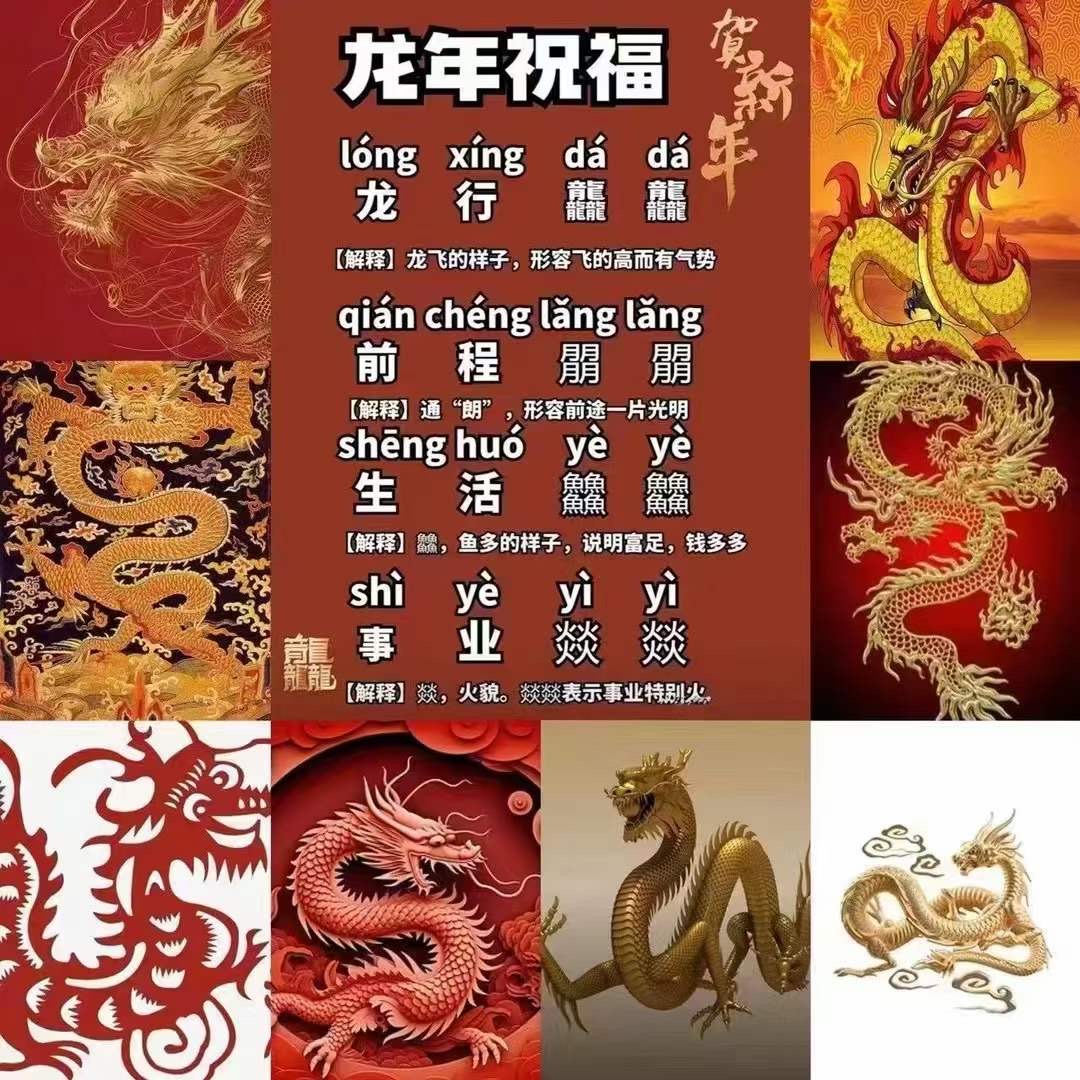Lunar New Year's greetings, part 1
« previous post | next post »
A bit belated, but better late than never.
Except for the first line, which is "lóngnián zhùfú 龙年祝福" ("blessings for the year of the dragon"), all the other lines (the quatrain that follows the titular greetings) come with pinyin phonetic annotation, which led me to believe that I could dispense with the obligatory LL romanization. It turns out, however, that the quatrain constitutes an episode of sinoglyphic suffering / torture, with the second half of each line consisting of a pair of reduplicated, witheringly multistroke monstrosities that are so obscure they require annotation, and each of the repeated pair of characters composed of three or four repetitions of "normal" characters: lóng 龍 ("dragon"), yuè 月 ("moon"), yú 魚 ("fish"), huǒ 火 ("fire").
Here are the translations of the explanations of the four lines:
1. the appearance of dragons flying high and with momentum / force / vigor / energy / imposing manner
2. describes a bright future
3. the appearance of many fish, indicating [a life of] abundance and wealth
4. fiery looks, expressing that one's career / business is especially blazing
To be continued.
Selected readings
- "A (troop / troupe of) dragon(s) tromping / flying" (12/4/23)
- "Writing Chinese characters as a form of punishment" (11/1/15)
- "The Awful Chinese Writing System" (Lingua Franca, 1/20/16)
- "A Chinese character that is harder to write than 'biang'" (7/30/20) — includes remarks about the essential squareness of Chinese writing

DS Zhang said,
February 17, 2024 @ 12:36 pm
These quadruplets of sinographs, making one big character — though tortuous to write, seem to be another interesting artistic exploration, of what one could do with the hanzi writing system. Bad from an orthographic / practical perspective, yet not so much from an artistic one though.
Also, believe it or not, I know yè 䲜 and yì 燚 from my first grade in elementary school. Actually, all the 200 kids from my entire grade (niánjí 年级), four classes, in the same elementary school in Dalian, China, know these two characters since age 6-7. How? Because there were a family of quadruplets, from our grade, with such names! The four kids' names were xiǎoyè 小䲜, xiǎoyì 小燚, then one xiǎomàn 小㵘 (same as màn 漫, "water vastly flowing") and also xiǎomǎng 小茻 ("lush vegetation flourishing"). The first two are boys and the last two are girls. They were so famous in my school because of those names. I guess their parents named them so, because they were quadruplets and these Chinese characters were also "quadruplets". Fish, fire, water, grass. Quite poetic in intention but must be painstaking to write for themselves!
This quatrain brings back vivid memories of those four identical-looking young classmates of mine, with the coolest, most distinctive, yet perhaps hardest-to-write-and-recognize names. May they, who are long lost in touch now, have a good laugh at these quatrain, and thrive in their lives as their parents wish.
Terry Hunt said,
February 18, 2024 @ 4:53 am
An off-the-wall query, from one who has learned virtually nothing about Chinese orthography: has there ever been a practice (akin perhaps to shorthand) where such reduplicated characters have been written using the equivalent of a 'ditto mark' rather than writing out all four characters in full?
Rodger C said,
February 18, 2024 @ 10:47 am
Terry Hunt: As someone who knows slightly more about Chinese orthography, yes, there's a little thingie.